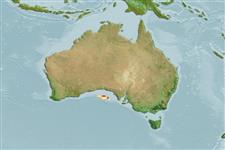ກຸ່ມປາກະດູກອ່ອນ (ເຊັ່ນ: ປາສະຫລາມ, ປາຜາໄລ) (sharks and rays) >
Rajiformes (Skates and rays) >
Arhynchobatidae (Softnose skates)
Etymology: Notoraja: Greek, noton = back + Latin, raja = fish, Raja sp. (Ref. 45335); sticta: Name from Greek 'stiktos' meaning spotted or dappled, refers to its strong blotched dorsal coloration.
More on authors: McEachran & Last.
Environment: milieu / climate zone / depth range / distribution range
ນິເວດວິທະຍາ
ສັດທະເລ ກ່ຽວກັບ(ຢູ່)ຊັ້ນນ້ຳໃນທະເລທີ່ເໜີອພື້ນດິນ; ລະດັບຄວາມເລິກ 820 - 1200 m (Ref. 75642). Temperate; 33°S - 35°S, 129°E - 133°E (Ref. 114953)
Eastern Indian Ocean: Great Australian Bight, South Australia.
ຂະໜາດ / ນ້ຳໜັກ / Age
Maturity: Lm ? range ? - ? cm
Max length : 62.7 cm TL ຕົວຜູ້/ບໍ່ມີເພດ; (Ref. 75642)
A demersal species found on continental slope (Ref. 114953). Length of this species reaches at least 62.7 cm TL; adult males 52.5-54.3 cm TL, a juvenile male paratype at 50.8 cm TL, the smallest specimen was 27.1 cm TL (Ref. 75642). Rarely caught and few individuals exist in museum collections (Ref. 114953).
Life cycle and mating behavior
ການຈະເລີນເຕັມໄວ | ການສືບພັນ | ການວາງໄຂ່ | ໄຂ່ | ຄວາມດົກຂອງໄຂ່ປາ | ຕົວອ່ອນ
McEachran, J.D. and P.R. Last, 2008. New deepwater skates of the genus Notoraja (Rajoidei: Aehynchobatidae) from southern Australia and the eastern Indian Ocean. In Last, P.R., W.T. White, J.J. Pogonoski and D.C. Gledhill (eds): Descriptions of new Australian skates (Batoidea: Rajoidei) Pg. 155-172. CSIRO marine and atmospheric research paper no. 021. (Ref. 75642)
IUCN Red List Status (Ref. 130435: Version 2024-1)
Threat to humans
Harmless
Human uses
ເຄື່ອງມື
Special reports
Download XML
ແຫຼ່ງອີນເຕີເນັດ
Estimates based on models
Preferred temperature (Ref.
123201): 2.1 - 5.5, mean 5 °C (based on 26 cells).
Phylogenetic diversity index (Ref.
82804): PD
50 = 0.5001 [Uniqueness, from 0.5 = low to 2.0 = high].
Bayesian length-weight: a=0.00562 (0.00288 - 0.01097), b=3.11 (2.94 - 3.28), in cm total length, based on LWR estimates for this (Sub)family-body shape (Ref.
93245).
ຊັ້ນເຂດຮ້ອນ (Ref.
69278): 3.8 ±0.7 se; based on size and trophs of closest relatives
ຄວາມຢືດຢຸ່ນ (Ref.
120179): ຕຳ່, ປະຊາກອນຕຳ່ສຸດທີ່ໃຊ້ເວລາສອງເທົ່າ 4.5 - 14 ປີ (Preliminary K or Fecundity.).
Fishing Vulnerability (Ref.
59153): Moderate to high vulnerability (45 of 100).
